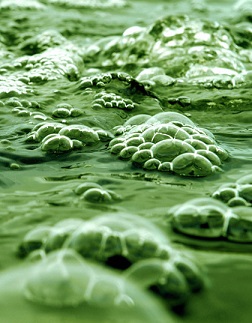New waste tech tested
 Australian researchers are working on an improved wastewater system using algae to accelerate the breakdown of effluent.
Australian researchers are working on an improved wastewater system using algae to accelerate the breakdown of effluent.
The system could be a significant breakthrough in cheaper and more efficient wastewater management, according to a new report by Flinders University researchers.
“This system has the potential to dramatically increase the availability of water for reuse in rural communities,” says Professor Howard Fallowfield,.
Prof Fallowfield has led research for the past 10 years into the use of high-rate algal pond systems (HRAP) for treating wastewater in South Australian rural communities..
“These sustainable, low-energy systems are cost effective to run, and the capital cost of construction is also about 40 per cent of the previous system for effluent-only schemes, and marginally higher for blackwater schemes,” he said.
The study compared HRAP systems side-by-side with a conventional system at a Loxton-Waikerie District Council trial site at Kingston-on-Murray.
“The study demonstrated that high-rate algal ponds are a viable alternative to waste stabilisation ponds for the treatment of wastewater in rural South Australian communities and elsewhere,” Prof Fallowfield says.
“While a conventional system requires 66 days to treat the wastewater, HRAPs can perform a similar level of treatment in 5-10 days. Its ability to remove pathogens is equal to, or better than, existing wastewater systems.”
By providing more reclaimed water to irrigate local woodlots, the experts say the new system is a winner both environmentally and economically.
The study evaluated the performance of the HRAP at Kingston-on-Murray over two years when fed 12 cubic metres a day of either treated effluent from on-site septic tanks, or a facultative pond further treating the septic tank effluent from the local community of 300 people.
In 2016, the wastewater treatment system was accepted by the SA Department of Health Wastewater Management Group as an alternative to existing passive lagoon systems for use in SA.
It showed that, generally, wastewater treatment and biomass production was improved when the HRAP was fed septic tank effluent:
- Wastewater from septic tanks was treated more effectively than from facultative pond
- 90 per cent BOD5 was removed, mean biomass production was 31.7g m−1 day−1, and only nitrogen removal was influenced by pond depth
- E. coli disinfection was acceptable when operated at 0.32 m depth and at four-day retention time
The composition of the incoming wastewater affected the treatment performance; the stronger septic tank effluent was better treated and produced more algal biomass for subsequent exploitation than facultative pond effluent.








 Print
Print